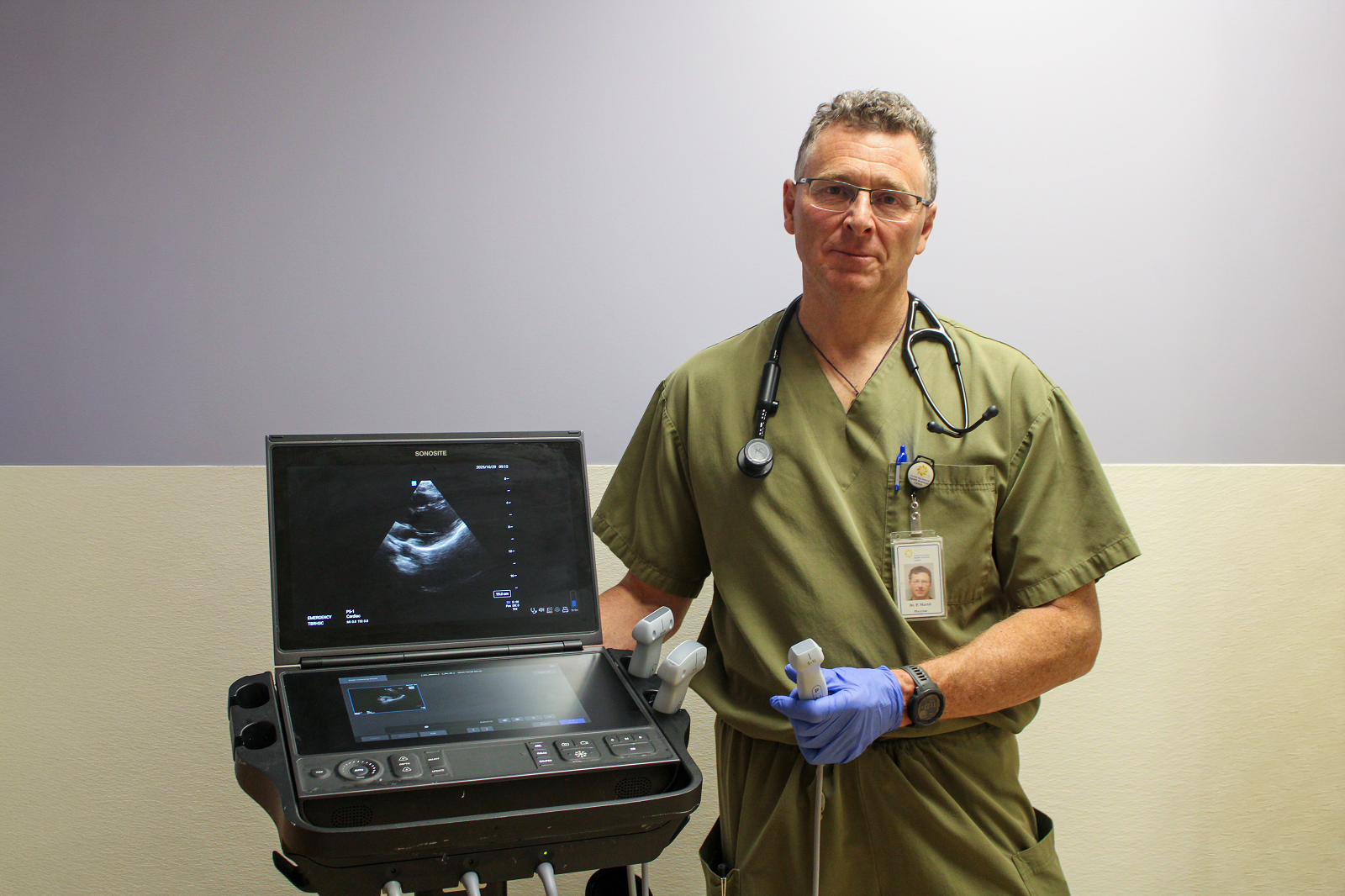Your Impact: How Bedside Ultrasound Helps Improve Patient Care
Published Monday, November 17, 2025

Dr. Patrick Martel, Point-of-Care Ultrasound Lead at the Thunder Bay Regional Health Sciences Centre, with the advanced PoCUS system helping clinicians diagnose patients faster, made possible through donor support.
They say a picture is worth a thousand words. But when it's an emergency and you need to see what's happening inside the body, that picture becomes even more valuable.
Take for example a patient who comes into the Emergency Department with shortness of breath. Is it asthma? COPD? Pneumonia? Heart failure? Something else?
Thanks to you, trained physicians in the Emergency Department and the ICU at the Thunder Bay Regional Health Sciences Centre can use the latest ultrasound imaging systems at the bedside to potentially find out faster. Each of these two departments has a new point-of-care ultrasound (PoCUS) system that allows doctors to identify common problems so that they can start appropriate treatments earlier. Other clinicians including nurses can also use the system for patient assessments.
Although PoCUS itself is not new, advancements in technology have made it more and more useful. These newest systems purchased with your donations are a huge upgrade from the previous technology.
“The new Sonosite unit is a beautiful machine – it's like the Ferrari of PoCUS,” said Dr. Patrick Martel, an emergency physician at the Hospital and an Associate Professor at the Northern School of Medicine University (NOSM U).
He would know. Dr. Martel trained on some of the first PoCUS units in the early 2000s.
“The first PoCUS I used was small – the screen was maybe the size of my phone – and it was really, really grainy. It gave you minimal information,” he said. PoCUS technology has exploded in the last 25 years. “It's like going from that tiny black and white TV that your grandparents had to an Ultra-HD flat screen today.”
Part of what makes PoCUS so useful is that before sending a patient to Diagnostic Imaging, the physician can essentially extend their physical using ultrasound themselves at the bedside. That's a huge benefit in the Emergency Department when minutes and even seconds count, or when patient is too unstable to be sent to Diagnostic imaging.
Take the shortness of breath example, above. Obviously, treating asthma is much different from treating heart failure, even though the symptoms can be similar. Doctors are trained to take in all the symptoms to make treatment decisions – they've done that successfully since long before ultrasound. What PoCUS does is give doctors more information sooner so they can make appropriate decisions faster. In turn, patients get the treatment they need faster for better care – and better outcomes.
“PoCUS improves the bedside assessment,” Dr. Martel said.
The ultrasound system can also be used for image-guided procedures such as removing fluid build-up inside the body.
“You can use the ultrasound to determine the best place to drain that fluid, and then helps you put that needle in exactly the right spot,” he said. “It helps make procedures like this safer and more precise.”
These are just a few of the many ways PoCUS helps doctors diagnose diseases, conditions, and injuries faster. Today's new Sonosite PoCUS is portable, so it can be wheeled anywhere including the bedside in the Emergency Department. Its large, high-res screen clearly shows the area of the body the doctor needs to look. Special attachments like the transesophageal echocardiogram (TEE) allow doctors to visualize from different angles for even more information.
If you think this sounds like Star Trek, you're not far off. Dr. Martel – who is a Star Trek fan himself – said today's ultrasound units are just the beginning.
“If you get me dreaming, I'd like that booth that closes over the patient and gives you whole, instantaneous imaging and monitoring as you're doing assessments and procedures. That's the future.”
The Emergency Department now has one of the most advanced PoCUS systems available, thanks to your donations to the Thunder Bay Regional Health Sciences Foundation, your participation in Foundation events, and your purchase of Thunder Bay 50/50 tickets.
Find out more ways you're helping improve patient care every day: healthsciencesfoundation.ca/news
Article by: Graham Strong